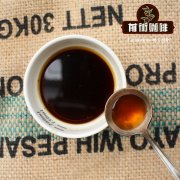Which are the eight producing areas of Guatemalan coffee in Guatemala?

For professional baristas, please follow the coffee workshop (Wechat official account cafe_style)
The latitude of Guatemala is about 15 degrees. Because of the long mountains and great regional climate changes, Guatemala's eight major coffee producing areas are all located in the highland topography under the subtropical climate, with rich and stable rainfall and excellent environment for fertile volcanic ash soil. the coffee beans produced are all Arabica, each with different flavors and characteristics, excellent sour taste and fruity aroma. It is one of the top coffee in the world and is suitable for individual consumption.
Antigua Antigua
Rich volcanic soil, low humidity, strong sunlight and cool night breeze are the characteristics of the Antigua area. Three spectacular active volcanoes-the Water Volcano, the Akardenango Volcano and the Fire Volcano-form a beautiful valley.
High-end Antigua coffee is full-bodied and mild, mellow aroma and good acidity
Akkad Nango Valley Acatenango Valley
In the emerging coffee growing area of the country, at an altitude of 2000 meters, the lush forests shade the coffee trees planted by small farmers, but also block the heat from the Pacific Ocean, and turn into a moist airstream with acidity and rich fragrance. It's memorable.
Koban Rain Forest Rainforest Cobb á n
The area is shrouded in clouds throughout the year, abundant rainfall and a cool climate, and the local soil is composed of limestone and clay. Under the influence of the Atlantic basin and the northward jungle tropical climate, most of the coffee in this area is grown on obviously slow hills, and the characteristics of coffee in this area are quite different from those in other producing areas of the country. The bean body is full, with bright and subtle sour taste, with a light wine aroma.
Mount San Marcos Volcanic San Marco
It is the warmest coffee producing area in the country. The area has abundant rainfall, the rainy season is the densest, and the flowering stage is the earliest. The rainy season is at its best between June and September, even with torrential rains, with annual rainfall as high as 197 inches in some areas. The coffee in this area has an obvious sour taste, full beans, with a clear, faint floral aroma.
Traditional Traditional Atitl á n
One of the four major volcanic coffee zones in Guatemala. The soil of Attland is full of fertile organic matter. 90% of the coffee is grown along extremely steep slopes all the way to Lake Attilan, the largest and most famous volcanic lake in Guatemala. The coffee in this area is fragrant and intoxicating, with sweet taste and full beans.
Towering highland Highland Huehue
Among the three non-volcanic areas, coffee production is the driest and highest-lying area. The towering Denangao is currently the most rugged and remote part of Guatemala. Because of the hot and dry wind blowing into the mountains from the Dehuang de Pecke Plain in Mexico, the mountains are free from frost, so coffee can be grown at a height of up to 6500 feet. The coffee beans in this area are firm and full, with a special sour taste and a slight wine aroma.
Farrakhan Nice Plain Fraijanes Plateau
The volcanic altitude in this area is quite high, the soil is rich in pumice, and the Farrakhan Nice Plain is still an active volcanic area, so the coffee in this area is similar to that of Antigua. However, Rain Water's abundance, high and varied humidity, and large temperature difference give the Farrakhan Nice Plain a very different flavor. Contains quite elegant aromas, mild and mellow overall texture, with special and pleasant acidity
New Oriental New Oriente
Rain Water is abundant and the climate is similar to that of Koban, but the New Oriental is a volcanic area and the soil contains a lot of metamorphic rocks. Coffee cultivation is also quite different from the general Guatemalan volcanic area, New Oriental coffee grows in volcanic soil, and there is no volcanic activity during the growth period. It is the latest coffee producing area in Guatemala, characterized by aroma, obvious acidity and fairly good texture.
Important Notice :
前街咖啡 FrontStreet Coffee has moved to new addredd:
FrontStreet Coffee Address: 315,Donghua East Road,GuangZhou
Tel:020 38364473
- Prev

What are the benefits of blue mountain coffee? Here are the benefits of drinking more coffee
For professional baristas, please follow the coffee workshop (Wechat official account cafe_style) 1. Coffee energizes you and makes you smarter. After drinking it, caffeine is absorbed into the bloodstream and transported to the brain, blocking an inhibitory neurotransmitter called adenosine, causing excitement. This improves a variety of brain functions, including memory and emotion.
- Next

What are the characteristics of Kenyan coffee? Flavor description of Kenyan Coffee
Professional baristas exchange please follow the coffee workshop (Wechat official account cafe_style) high-quality Kenyan coffee aromatic, rich, with fruit flavor, rich and perfect taste. Kenyan coffee has a wonderful fruit flavor, tastes like BlackBerry and grapefruit, and is a favorite of many coffee gluttons. This coffee has excellent medium purity, crisp and clear
Related
- Detailed explanation of Jadeite planting Land in Panamanian Jadeite Manor introduction to the grading system of Jadeite competitive bidding, Red bid, Green bid and Rose Summer
- Story of Coffee planting in Brenka region of Costa Rica Stonehenge Manor anaerobic heavy honey treatment of flavor mouth
- What's on the barrel of Blue Mountain Coffee beans?
- Can American coffee also pull flowers? How to use hot American style to pull out a good-looking pattern?
- Can you make a cold extract with coffee beans? What is the right proportion for cold-extracted coffee formula?
- Indonesian PWN Gold Mandrine Coffee Origin Features Flavor How to Chong? Mandolin coffee is American.
- A brief introduction to the flavor characteristics of Brazilian yellow bourbon coffee beans
- What is the effect of different water quality on the flavor of cold-extracted coffee? What kind of water is best for brewing coffee?
- Why do you think of Rose Summer whenever you mention Panamanian coffee?
- Introduction to the characteristics of authentic blue mountain coffee bean producing areas? What is the CIB Coffee Authority in Jamaica?

